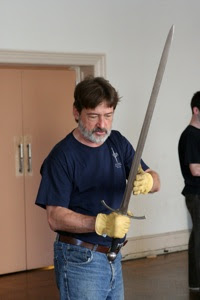I would have to say that it has taken me the past 40 plus years to develop the paradoxical mix of of raw talent, critical analysis, absolute physical and mental control and complete emotional abandon that is the craft of acting, and it is what I try to impart as an acting instructor.
 | |||||||||
|
A Bright
Room Called Day
Photo: Owen
Carey
|
As director I stress the importance of making specific and active choices that will lead the actor to a more fully realised and multi-dimensional character. A full exploration of the character's backstory, given circumstances, objectives, obstacles and tactics steer the actor toward those goals. Understanding the character's "why" will logically raise the emotional stakes in any given scene and heighten the conflict in the story - and telling the story is everyone's goal in play production.
Story can sometimes elude an actor who is involved in the minutiae of their character's development and specific scenework. However, where and how a character fits into the overall storyline and theme of a play help the actor make choices that drive the action of the story. A director becomes the objective guide to that process, and an actor must understand the importance of the collaborative process during rehearsal. Therefore, each actor will develop a "beat analysis" which become a road map for the character’s emotional life and how that fits into the overall scope of the play.
Each actor will create a journal to help them understand how the creative process affected them, how they dealt with it, what worked and what didn't. The journal becomes a mirror for them to see how they work.
The actual run of a play can be just as daunting as the rehearsal process. Sustaining a performance and growing within the restraints of the director’s and playwright's visions are important ingredients in the creative process. The actor must learn how to approach each night's performance as a clean slate, remembering the structure, while simultaneously staying free enough to react spontaneously to the "given circumstances" of that particular evening’s performance.
Although I later trained at a conservatory and worked in repertory theatre in dozens of plays, it is when I became a film actor I began to see that acting required a focus on truth and honesty, and that my best work came from reacting, rather than generating a "performance." It turned my head in the right direction and turned me into a better actor. This simple truth is what I try to instill in all my students. It does not mean an actor ignores the other ingredients that make for an interesting, and sometimes brilliant performance. Character development, back-story, script analysis, moment before, motivation, intention, active choices and need are all important ingredients in the creating a living, multi-dimensional character. However, the one underlying bonding force that keeps an actor focused and in-the-moment, is, as I like to call it, the luxury of reacting as if it were the first time.
About Shelly Lipkin:
Shelly is an actor, director, playwright and acting instructor. He studied acting at
As a playwright, he received a RACC Grant, a Literary Arts Fellowship, and an Oregon Arts Commission Fellowship to develop his second play, Sylver Beaches, which recently had a staged reading in Paris, (yes, France), and was nominated for an Oregon Book Award. It is currently in development as a screenplay. In the past he has taught at












